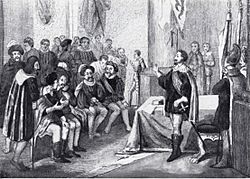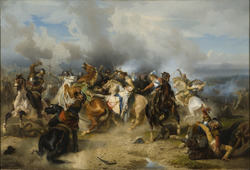Heilbronn League facts for kids
Quick facts for kids
Heilbronn League
|
|
|---|---|
| 1633–1635 | |

Founding of the Heilbronn League, April 1633
|
|
| Common languages | French and German |
| League Director | |
|
• 1633–1635
|
Axel Oxenstierna |
| Historical era | 1633 to 1635 |
|
• Established
|
23 April 1633 |
|
• Dissolved, following the Peace of Prague
|
30 May 1635 |
The Heilbronn League was an important group formed during the Thirty Years' War. It was created in the city of Heilbronn, Germany, on April 23, 1633. This league brought together many Protestant states in western and northern Germany.
Sweden led the League, and France helped by giving money. Even though the members had different goals, the League had some good successes. However, it was defeated at the Battle of Nördlingen in November 1634.
After this defeat, Emperor Ferdinand was able to make peace with his Protestant enemies. The Peace of Prague agreement in 1635 largely ended the fighting among states within the Holy Roman Empire. The Heilbronn League was then officially ended. But the war in Germany continued until 1648, mostly because other countries like France and Sweden were still involved.
Contents
Why the League Was Needed
The Thirty Years' War started in 1618. At first, many German Protestants tried to stay out of the fighting. But things changed in 1629.
Emperor Ferdinand made a rule called the Edict of Restitution. This rule said that any land taken from the Catholic Church since 1552 had to be given back. This meant that many Protestant areas would lose their land.
Also, the Emperor let his armies take supplies and money from any land they marched through. This included lands belonging to his own allies.
Because of these reasons, Saxony and Brandenburg-Prussia joined Gustavus Adolphus of Sweden. He invaded the Holy Roman Empire in 1630. Sweden joined the war to help other Protestants and to control important trade routes in the Baltic Sea. France also paid Sweden to fight, because France was worried about the Emperor's growing power near its borders.
The Protestant side won several battles. A big victory was at Lützen in November 1632. But during this battle, King Gustavus Adolphus of Sweden died. This was a big loss for the Protestant cause.
Forming a Strong Alliance
After King Gustavus Adolphus died, his daughter Christina became queen. She was only six years old. So, Axel Oxenstierna, a very important Swedish leader, took charge of Sweden's plans.
Oxenstierna wanted to make the alliance stronger. He felt that the previous agreements were too loose. He also wasn't sure if Sweden's allies would always be reliable.
Different allies had different goals. Sweden wanted to keep its control over the Baltic Sea. But Brandenburg also wanted to control trade there. Saxony's leader, Elector John George, saw Sweden as almost as big a threat as the Emperor.
After the Battle of Lützen, John George suggested a meeting of German Protestants. He wanted to make a peace deal. France also stopped paying Sweden for a while to see what would happen. Emperor Ferdinand could have used this chance to make peace, but he wanted to win more battles.
In March 1633, Oxenstierna invited leaders from several German regions to Heilbronn. These regions included the Upper Rhenish, Lower Rhenish–Westphalian, Swabian, and Franconian Circles.
The Heilbronn League was officially formed on April 27, 1633. France started paying Sweden again, and these payments went directly to Sweden. This helped Sweden keep control of the League. Oxenstierna became the League Director. He had the final say on military matters. He also had a council of ten advisors, including three Swedes.
The members agreed to pay for a large army. However, they actually provided much less money than needed. The German members agreed to keep fighting until Sweden got what it wanted. Oxenstierna promised to help return Germany to its borders from before 1618.
The League Ends: Peace of Prague
The Heilbronn League, with some help from Saxony and Brandenburg, won several battles against the Catholic League. But in 1634, the Imperial army won a big victory at the Battle of Nördlingen. This battle made the two sides more equal in strength. It also gave Emperor Ferdinand another chance to make peace.
The League members and their supporters had different ideas about what they wanted. France wanted to protect its borders near the Rhineland and the Low Countries. Sweden wanted to keep its power in the Baltic Sea. The German allies of the League wanted to go back to the way things were in 1618, before the war caused so many changes.
By the end of 1633, Emperor Ferdinand realized he couldn't force everyone to be Catholic. With help from Denmark-Norway and Hesse-Darmstadt, he started talking with John George of Saxony. In November 1634, they agreed on a first draft for peace.
This draft became the basis for the Peace of Prague agreement in 1635. This peace treaty officially ended both the Catholic League and the Heilbronn League.
Sources
See also
 In Spanish: Liga de Heilbronn para niños
In Spanish: Liga de Heilbronn para niños



